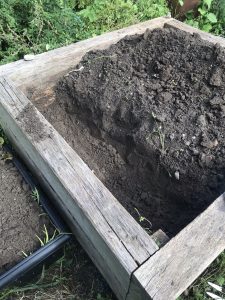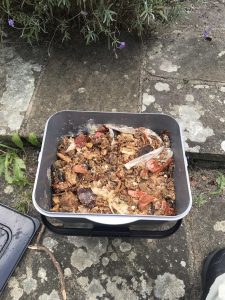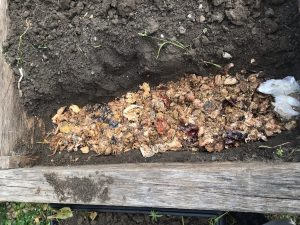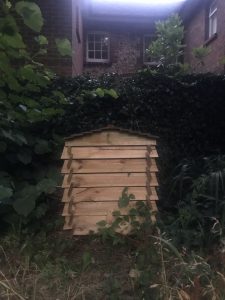Bokashi bin update
This is part two of what could be a long running saga. See part one here.
Four months after starting my Bokashi journey, I have finally taken the plunge and buried my first bucket of food-waste. I could have done this eight weeks ago, but I had two options for using this delicious compost and dithered about which to try. Should I tip it into my new garden compost bin*, or should I add it directly into the soil? Having decided to add it to a vegetable bed, I then had to wait until the resident potato crop was finished and that day came today!
I dug a rough trough, about 12″ deep and about one quarter the width of the bed. It would have made more sense to spread the compost over the entire bed, but that would have involved a lot more digging and I was just a little bit too impatient. I justified my laziness, by declaring this an experiment. I would wait to see whether veg grown above the Bokashi compost fared any better than the rest of the bed. I’ll let you know.

The food in the Bokashi bin had been quietly fermenting in the kitchen and then the shed for 2-4 months. Far longer than needed, but this did it no harm. You’ll notice from the photo that the food is now mostly shades of brown, apart from a few patches of healthy white mould. The food had been a variety of greens, reds, yellows and whites when it first entered the bin. You’ll also notice that it is not fully broken down. This is expected. Once in the soil it will continue fermenting at a much faster rate and combine with the soil. What you can’t tell is how it smells, so you’ll have to take my word for it. It smells really sweet, wafts of yeast, honey, apples, vinegar, or a very poky scrumpy.

It was soft and mushy, so spread very easily. Just like making mud pies again.

Finally I raked the soil back over, burying the compost about 12″ deep. I haven’t decided what to plant here yet, maybe leeks, but I can’t wait to see the results.

So what have I learned over the last four months?
It has been much easier and more enjoyable than I anticipated. Until about a week ago, when I had filled both my Bokashi bins, I had no food waste at all. This felt like a real achievement.
I kept the bin I was filling in the kitchen and the full bin in the shed. This made it easier to tell which was which. The bins are airtight (they have to be for the process to work), so no smells escaped into the kitchen. Even when I opened the bin, the aromas were pleasant (in my view)!
The original plan was to put all raw, green waste into the garden compost and only put food that could not be composted (cooked food, dairy, fish) into the Bokashi bin. But further advice from my original Bokashi mentor, David Herson, was to keep the Bokashi bin balanced with a mixture of cooked food and raw vegetables. So roughly half my potato peelings, onion skins, cauliflower leaves etc. went straight into the garden compost and the other half was added to the Bokashi bin. And, l was very pleased to learn that you can add teabags to the Bokashi bin, as long as the bags have no plastic content.
Once I am confident that the family are fully trained and know how to dispose of food waste, I plan to remove the large pedal bin from the kitchen as it shouldn’t be needed. I should be OK with:
- a Bokashi bin for food waste
- two tiny counter top bins for green waste and other food waste
- recycling bin for paper, card, plastic, glass that can’t be reused
- a very small bin for non-recyclable packaging
A garden compost bin completes the set
When I wrote the first Bokashi post, I was hoping to receive a garden compost bin for my birthday*. Well I was lucky: a lovely wooden ‘beehive style’ bin arrived in about 75 pieces. Double the fun as I got to play with a hammer, electric drill and screwdriver. I’m a complete amateur when it comes to garden compost, so this is yet another adventure, wondering what sort of potions I will produce.

Bokashi without a garden
This year, Eastbourne moved to fortnightly collections for household waste. This appears to be causing huge problems in the town centre with complaints about overflowing dustbins smelling of rotten food, flies, maggots and worse. Bokashi bins could help here. Because they don’t smell and the food ferments, rather than putrefying, residents could keep food waste safely in a Bokashi bin with added bran until their bins are emptied. The council should be able to buy very cheaply in bulk. Just a thought.

Hi it looks really good.Do you think it would work for a small or single household? Would it be slower ? I guess so….anyone know?
Yes, it will work just as well for a small household. There is no rush to fill the bin.
Great stuff Jill and well documented! The garden compost bin as birthday present proves just how keen you are. Inspiring.